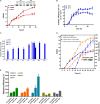Vibrio natriegens as a pET-Compatible Expression Host Complementary to Escherichia coli
- PMID: 33679648
- PMCID: PMC7933001
- DOI: 10.3389/fmicb.2021.627181
Vibrio natriegens as a pET-Compatible Expression Host Complementary to Escherichia coli
Abstract
Efficient and novel recombinant protein expression systems can further reduce the production cost of enzymes. Vibrio natriegens is the fastest growing free-living bacterium with a doubling time of less than 10 min, which makes it highly attractive as a protein expression host. Here, 196 pET plasmids with different genes of interest (GOIs) were electroporated into the V. natriegens strain VnDX, which carries an integrated T7 RNA polymerase expression cassette. As a result, 65 and 75% of the tested GOIs obtained soluble expression in V. natriegens and Escherichia coli, respectively, 20 GOIs of which showed better expression in the former. Furthermore, we have adapted a consensus "what to try first" protocol for V. natriegens based on Terrific Broth medium. Six sampled GOIs encoding biocatalysts enzymes thus achieved 50-128% higher catalytic efficiency under the optimized expression conditions. Our study demonstrated V. natriegens as a pET-compatible expression host with a spectrum of highly expressed GOIs distinct from E. coli and an easy-to-use consensus protocol, solving the problem that some GOIs cannot be expressed well in E. coli.
Keywords: Vibrio natriegens; fermentation optimization; pET expression system; recombinant protein; synthetic biology.
Copyright © 2021 Xu, Dong, Wu, Tao, Yang, Wu, Jiang, Yang and Yang.
Conflict of interest statement
RT was employed by company Huzhou Yisheng Biotechnology Co., Ltd. YJ was employed by company Shanghai Taoyusheng Biotechnology Co., Ltd. The remaining authors declare that the research was conducted in the absence of any commercial or financial relationships that could be construed as a potential conflict of interest.
Figures



Similar articles
-
A novel global transcriptional perturbation target identified by forward genetics reprograms Vibrio natriegens for improving recombinant protein production.Acta Biochim Biophys Sin (Shanghai). 2021 Aug 31;53(9):1124-1133. doi: 10.1093/abbs/gmab089. Acta Biochim Biophys Sin (Shanghai). 2021. PMID: 34169308
-
[Secretory expression and fermentation optimization for extracellular production of pullulanase in Vibrio natriegens].Sheng Wu Gong Cheng Xue Bao. 2023 Aug 25;39(8):3421-3435. doi: 10.13345/j.cjb.220971. Sheng Wu Gong Cheng Xue Bao. 2023. PMID: 37622370 Chinese.
-
Comparison of simple expression procedures in novel expression host Vibrio natriegens and established Escherichia coli system.J Biotechnol. 2020 Sep 10;321:57-67. doi: 10.1016/j.jbiotec.2020.06.003. Epub 2020 Jun 23. J Biotechnol. 2020. PMID: 32589894 Review.
-
Recombinant Protein Expression Chassis Library of Vibrio natriegens by Fine-Tuning the Expression of T7 RNA Polymerase.ACS Synth Biol. 2023 Feb 17;12(2):555-564. doi: 10.1021/acssynbio.2c00562. Epub 2023 Jan 31. ACS Synth Biol. 2023. PMID: 36719178
-
Ploidy in Vibrio natriegens: Very Dynamic and Rapidly Changing Copy Numbers of Both Chromosomes.Genes (Basel). 2023 Jul 13;14(7):1437. doi: 10.3390/genes14071437. Genes (Basel). 2023. PMID: 37510340 Free PMC article. Review.
Cited by
-
Using Vibrio natriegens for high-yield production of challenging expression targets and for protein deuteration.bioRxiv [Preprint]. 2023 Nov 3:2023.11.03.565449. doi: 10.1101/2023.11.03.565449. bioRxiv. 2023. Update in: Biochemistry. 2024 Mar 5;63(5):587-598. doi: 10.1021/acs.biochem.3c00612. PMID: 37961550 Free PMC article. Updated. Preprint.
-
Unraveling the impact of pH, sodium concentration, and medium osmolality on Vibrio natriegens in batch processes.BMC Biotechnol. 2024 Sep 23;24(1):63. doi: 10.1186/s12896-024-00897-8. BMC Biotechnol. 2024. PMID: 39313794 Free PMC article.
-
Efficient natural plasmid transformation of Vibrio natriegens enables zero-capital molecular biology.PNAS Nexus. 2024 Feb 13;3(2):pgad444. doi: 10.1093/pnasnexus/pgad444. eCollection 2024 Feb. PNAS Nexus. 2024. PMID: 38352175 Free PMC article.
-
Using Vibrio natriegens for High-Yield Production of Challenging Expression Targets and for Protein Perdeuteration.Biochemistry. 2024 Mar 5;63(5):587-598. doi: 10.1021/acs.biochem.3c00612. Epub 2024 Feb 15. Biochemistry. 2024. PMID: 38359344 Free PMC article.
-
Unlocking the strength of inducible promoters in Gram-negative bacteria.Microb Biotechnol. 2023 May;16(5):961-976. doi: 10.1111/1751-7915.14219. Epub 2023 Feb 3. Microb Biotechnol. 2023. PMID: 36738130 Free PMC article.
References
-
- Broedel S. J., Papciak S., Jones W. (2001). The selection of optimum media formulations for improved expression of recombinant proteins in E. coli. Technic. Bull. 2.
-
- Bucher T., Krell H., Lusch G. (1974). Molar extinction coefficients of NADH and NADPH at Hg spectral lines. Z. Klin. Chem. Klin. Biochem. 12 239–240. - PubMed
LinkOut - more resources
Full Text Sources
Other Literature Sources
Molecular Biology Databases
Research Materials

